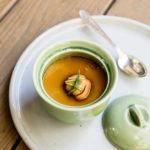Gluten-Free Chawanmushi (Savory Egg Custard) Recipe

With melt-in-your-mouth delicacy and plenty of umami, this savory, gluten free Japanese egg custard is astoundingly good and simple to prepare–so much so that we make it any time we want to impress guests. Don’t be deterred by the unfamiliar. This is one recipe you’ll be glad you took a risk on.

Chawanmushi (Savory Egg Custard)
Silken, savory, and naturally dairy-free, this Japanese egg custard by famed Napa Valley chef Hiro Sone is an impressive, easy-to-make first course. Though it’s traditionally served in small cups with lids, it’s easily made in ramekins or coffee mugs. The custard is so good, you could almost eat it by itself, but the glory is in baking a few edible goodies into it. To take it over the top, Hiro adds a finishing garnish of musky, melt-in-your-mouth uni (sea urchin), available at Japanese markets, and yuzu (Japanese citrus) peel, which can be replaced with lemon zest.
Ingredients
FOR THE CUSTARD:
- 3 eggs
- 2 cups homemade Dashi broth see below or instant dashi
- 4 teaspoons gluten-free tamari
- 3 tablespoons mirin rice wine
- Kosher salt
- 1⁄3 cup coarsely chopped cooked lobster shrimp, or crabmeat (optional)
- 6 3⁄4-inch cubes peeled sweet potato, cooked in salted water until tender
- 1⁄4 cup enoki mushrooms with stems cut about 1 inch from the cap
- Boiling water
FOR THE GLAZE AND SERVING:
- 1 teaspoon cornstarch
- 1⁄2 cup Dashi broth see below or instant dashi
- 3⁄4 teaspoon gluten-free tamari
- 1⁄2 teaspoon mirin
- Kosher salt
- 6 small pieces uni for garnish (optional)
- 2 teaspoons julienned mitsuba Japanese parsley or snipped chives, for garnish
- Yuzu or lemon zest for garnish
Instructions
-
Preheat the oven to 320°F. Make the custard: In a mixing bowl, gently whisk the eggs, trying not to make too much foam. Slowly whisk in 2 cups of the dashi, the tamari, and the mirin. Season with 1⁄2 teaspoon salt and strain through a fine-mesh sieve.
-
Divide the lobster, sweet potato, and mushrooms among six 6-ounce ramekins or larger coffee mugs. Gently pour the custard mixture over the ingredients to fill three-fourths of the way to the top. Tightly cover the ramekins with aluminum foil, place them in a roasting pan, put the pan in the oven, then pour enough boiling water into the pan to come two-thirds of the way up the outside of the ramekins. Cook until the custard bounces back when you gently touch its surface, about 25 minutes. Remove the pan from the oven.
-
Meanwhile, make the glaze: In a small bowl, mix together the cornstarch and 2 teaspoons water and set aside. In a small saucepan, combine the dashi, tamari, and mirin. Bring to a boil, reduce the heat to a simmer, add a pinch of salt, and slowly whisk in the cornstarch mixture. Return to a boil, then remove from the heat and keep warm.
-
Remove the custards from the water bath and discard the foil. To serve, gently place a piece of uni atop each custard, then gently spoon a bit of warm glaze around it. Garnish with mitsuba and yuzu zest. Serve immediately.
Dashi
Ingredients
- 1 3 by 2-inch piece dashi kombu (dried kelp)
- 1 cup loosely packed dried bonito flakes
Instructions
-
Clean the kombu with a damp paper towel. Place the kombu in a saucepan with 3 cups water. Set aside for 20 minutes.
-
Heat the water and kombu over low heat so it takes about 30 minutes to get close to boiling. Just before boiling, remove and discard the kombu, add the bonito flakes, bring the water to a boil, then simmer. Use a spoon to skim any foam that rises to the surface. Remove the water from the heat, wait for the bonito to sink to the bottom of the pan, then carefully ladle out the dashi broth, avoiding the bonito flakes as best you can. Strain the dashi through doubled cheesecloth, then cool, cover, and refrigerate until needed.
Recipe Hiro Sone and Lissa Doumani
Photography Aubrie Pick

